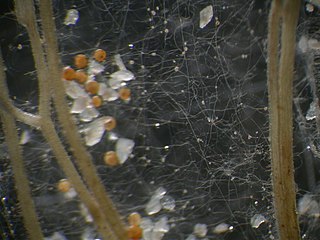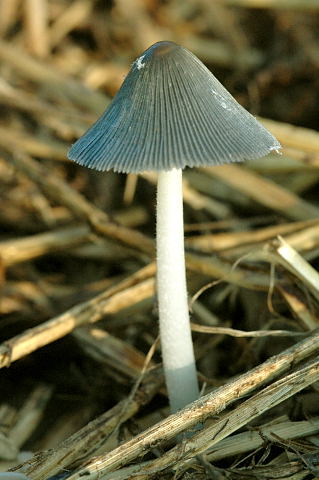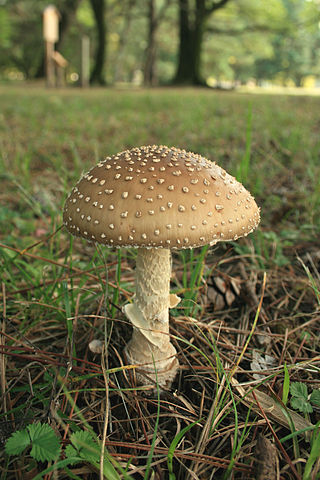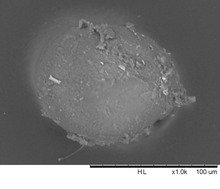
Ascomycota is a phylum of the kingdom Fungi that, together with the Basidiomycota, forms the subkingdom Dikarya. Its members are commonly known as the sac fungi or ascomycetes. It is the largest phylum of Fungi, with over 64,000 species. The defining feature of this fungal group is the "ascus", a microscopic sexual structure in which nonmotile spores, called ascospores, are formed. However, some species of the Ascomycota are asexual, meaning that they do not have a sexual cycle and thus do not form asci or ascospores. Familiar examples of sac fungi include morels, truffles, brewers' and bakers' yeast, dead man's fingers, and cup fungi. The fungal symbionts in the majority of lichens such as Cladonia belong to the Ascomycota.

A mycorrhiza is a symbiotic association between a fungus and a plant. The term mycorrhiza refers to the role of the fungus in the plant's rhizosphere, its root system. Mycorrhizae play important roles in plant nutrition, soil biology, and soil chemistry.

An arbuscular mycorrhiza (AM) is a type of mycorrhiza in which the symbiont fungus penetrates the cortical cells of the roots of a vascular plant forming arbuscules.
Glomalin is a glycoprotein produced abundantly on hyphae and spores of arbuscular mycorrhizal (AM) fungi in soil and in roots. Glomalin was discovered in 1996 by Sara F. Wright, a scientist at the USDA Agricultural Research Service. The name comes from Glomerales, an order of fungi. Most AM fungi are of the division Glomeromycota. An elusive substance, it is mostly known from its glue-like effect on soil and has not yet been isolated.

Glomeromycota are one of eight currently recognized divisions within the kingdom Fungi, with approximately 230 described species. Members of the Glomeromycota form arbuscular mycorrhizas (AMs) with the thalli of bryophytes and the roots of vascular land plants. Not all species have been shown to form AMs, and one, Geosiphon pyriformis, is known not to do so. Instead, it forms an endocytobiotic association with Nostoc cyanobacteria. The majority of evidence shows that the Glomeromycota are dependent on land plants for carbon and energy, but there is recent circumstantial evidence that some species may be able to lead an independent existence. The arbuscular mycorrhizal species are terrestrial and widely distributed in soils worldwide where they form symbioses with the roots of the majority of plant species (>80%). They can also be found in wetlands, including salt-marshes, and associated with epiphytic plants.
Glomus aggregatum is an arbuscular mycorrhizal fungus used as a soil inoculant in agriculture and horticulture. Like other species in this phylum it forms obligate symbioses with plant roots, where it obtains carbon (photosynthate) from the host plant in exchange for nutrients and other benefits.

Coprinopsis cinerea is a species of mushroom in the family Psathyrellaceae. Commonly known as the gray shag, it is edible, but must be used promptly after collecting.
Glomus is a genus of arbuscular mycorrhizal (AM) fungi, and all species form symbiotic relationships (mycorrhizae) with plant roots. Glomus is the largest genus of AM fungi, with ca. 85 species described, but is currently defined as non-monophyletic.

Dikarya is a subkingdom of Fungi that includes the divisions Ascomycota and Basidiomycota, both of which in general produce dikaryons, may be filamentous or unicellular, but are always without flagella. The Dikarya are most of the so-called "higher fungi", but also include many anamorphic species that would have been classified as molds in historical literature. Phylogenetically the two divisions regularly group together. In a 1998 publication, Thomas Cavalier-Smith referred to this group as the Neomycota.
Archaeosporales is an order of fungi best known as arbuscular mycorrhiza to vascular land plants (Tracheophyta). But also form free living endocyte symbioses with cyanobacteria. The free living forms have a Precambrian fossil record back 2.2 Ga, well before evolution of Tracheophyta.
The Paraglomerales are a group of exclusively hypogeous (underground) arbuscular mycorrhizal fungi that rarely produce vesicles and reproduce through unpigmented spores. It includes the species Paraglomus brasilianum, Paraglomus laccatum, and Paraglomus occultum.

A fungus is any member of the group of eukaryotic organisms that includes microorganisms such as yeasts and molds, as well as the more familiar mushrooms. These organisms are classified as a kingdom, separately from the other eukaryotic kingdoms, which by one traditional classification include Plantae, Animalia, Protozoa, and Chromista.

Mucoromycotina is a subphylum of uncertain placement in Fungi. It was considered part of the phylum Zygomycota, but recent phylogenetic studies have shown that it was polyphyletic and thus split into several groups, it is now thought to be a paraphyletic grouping. Mucoromycotina is currently composed of 3 orders, 61 genera, and 325 species. Some common characteristics seen throughout the species include: development of coenocytic mycelium, saprotrophic lifestyles, and filamentous.
The mycorrhizosphere is the region around a mycorrhizal fungus in which nutrients released from the fungus increase the microbial population and its activities. The roots of most terrestrial plants, including most crop plants and almost all woody plants, are colonized by mycorrhiza-forming symbiotic fungi. In this relationship, the plant roots are infected by a fungus, but the rest of the fungal mycelium continues to grow through the soil, digesting and absorbing nutrients and water and sharing these with its plant host. The fungus in turn benefits by receiving photosynthetic sugars from its host. The mycorrhizosphere consists of roots, hyphae of the directly connected mycorrhizal fungi, associated microorganisms, and the soil in their direct influence.

Rhizophagus is a genus of arbuscular mycorrhizal (AM) fungi that form symbiotic relationships (mycorrhizas) with plant roots. The genome of Rhizophagus irregularis was recently sequenced.

Rhizophagus irregularis is an arbuscular mycorrhizal fungus used as a soil inoculant in agriculture and horticulture. Rhizophagus irregularis is also commonly used in scientific studies of the effects of arbuscular mycorrhizal fungi on plant and soil improvement. Until 2001, the species was known and widely marketed as Glomus intraradices, but molecular analysis of ribosomal DNA led to the reclassification of all arbuscular fungi from Zygomycota phylum to the Glomeromycota phylum.

Mycorrhiza helper bacteria (MHB) are a group of organisms that form symbiotic associations with both ectomycorrhiza and arbuscular mycorrhiza. MHBs are diverse and belong to a wide variety of bacterial phyla including both Gram-negative and Gram-positive bacteria. Some of the most common MHBs observed in studies belong to the phylas Pseudomonas and Streptomyces. MHBs have been seen to have extremely specific interactions with their fungal hosts at times, but this specificity is lost with plants. MHBs enhance mycorrhizal function, growth, nutrient uptake to the fungus and plant, improve soil conductance, aid against certain pathogens, and help promote defense mechanisms. These bacteria are naturally present in the soil, and form these complex interactions with fungi as plant root development starts to take shape. The mechanisms through which these interactions take shape are not well-understood and needs further study.
Dr. Mohamed Hijri is a biologist who studies arbuscular mycorrhizal fungi (AMF). He is a professor of biology and research at the Institut de recherche en biologie végétale at the University of Montreal.

Mucoromycota is a division within the kingdom fungi. It includes a diverse group of various molds, including the common bread molds Mucor and Rhizopus. It is a sister phylum to Dikarya.
Rhizophagus clarus is an arbuscular mycorrhizal fungus in the family Glomeraceae. The species has been shown to improve nutrient absorption and growth in several agricultural crops but is not typically applied commercially.











